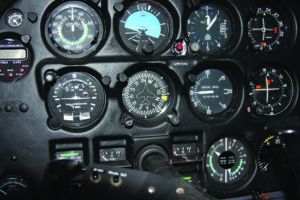I live in Fargo, North Dakota, where winter lasts anywhere from six to 13 months of the year. When I first moved back to Fargo after living elsewhere for quite a while—Fargoans call it “living abroad”—I asked the Fargo airport manager how much it would cost per month to tie down my airplane on his ramp. He looked at me as if I had told him I just flew in from the Moon, but he answered politely, like Fargo people do, saying, “Well, that would be free. But nobody does that.”
So it’s cold here, which explains the ice building up rapidly on my wings as I stupidly flew through the clouds at 8000 feet in late April. I was on an IFR flight plan from Flying Cloud Airport, KFCM. (Motto: “Wrong Runway Landings ‘R’ Us.” You scoff, but go there sometime.) I was at 14,000 feet, fat, dumb and happy. But then I wasn’t. Minneapolis Center said, “Lancair 214DK, descend and maintain 8000 feet.” I thought, “I have to do that, because he told me to,” and did. Turns out I shunta.
‘FREE TO MANEUVER’
I entered the clouds at about 9000 feet and immediately began picking up ice on the wings. I didn’t see it at first because I was busy looking for ice on the windscreen. But there was none. When I finally looked left, I saw ice from wingtip to root. Yikes! All white, the edges, and getting whiter.
The Lancair has thin, laminar-flow wings that don’t react well to ice. I was told that when training in it, and thought at the time, “Ho ho, I’ll never get into icing conditions. Not me!”
Suddenly, I was William Shatner in the Twilight Zone, turning to my buddy in the right seat and saying, “Look—at that stuff—on the wings.” He’s not a pilot so he didn’t have the same near-panic as I did. The Lancair has thin, laminar-flow wings that don’t react well to ice. I was told that when training in it, and thought at the time, “Ho ho, I’ll never get into icing conditions. Not me!”
I keyed the mic and said in what I hoped was a cool pilot voice, “Minneapolis Center, this is Lancair 214DK…I am picking up icing, rapid buildup, request an avoidance vector.” In response, ATC said, “Do you want a vector?” I replied, “Affirmative, I’d like to turn left immediately to avoid the icing, 4DK.” The controller came right back: “Lancair 214DK, you are free to maneuver as needed to avoid the ice. What altitude would you like?” By this time I was in a 45-degree bank doing a 180, looking out the cockpit at my white wings. I said, “Stand by one.”
SUCKER HOLE
Then I looked up and saw a blue hole in the clouds—blue sky! I think I saw the face of God, even. I said, “4DK, request 12,000 feet. I’d like to slip the surly bonds of icing.” No, I didn’t say all that. The controller snapped me out of my near panic, which I bet is a lot like real panic. They said in a clear, slow-paced voice: “214DK, you want to climb to avoid the icing?” Well, that snapped me out of it. I said, “Center, thank you for asking that—request lower, Lancair 214DK. I’ll go touch God’s face later.” (I may be embellishing here.)
The controller replied, “4DK, you are free to maneuver as necessary to avoid all those icebergs bobbing about in the North Sea. Descend and maintain 5000, cleared direct Fargo when able.” I dive down to 5000 feet like a P-51 chasing a Messerschmitt, boards out, and hey!—I see the ground! Clear sky beneath me and around me! Fergus Falls Municipal Airport never looked so good. In fact, I had never seen it before, but still.
The Minnesota State Mental Hospital used to be in Fergus Falls, I idly thought, thinking about how insane it was that I descended into ice-filled clouds from blue sky, no traffic within a hundred miles of me—just because some guy told me to.
WHOA, NELLY

The good news about this little icing scare is that I “got on the instruments, believed the instruments,” when I was doing all that yanking and banking in the clouds.
Eventually.
I was really trying to get clear of that ice, but didn’t panic and fly by “the seat of my pants,” which kills a pilot now and then. These towering cumulus clouds had little pockets of clear air here and there, so I was going from inside to outside of clouds at 9000 feet or so. I could hear my USAF instructor pilot’s voice saying, “Get on the instruments, believe the instruments.”
Well, I didn’t do that at first. I was flying in a little clear space, with what looked like shaving cream all over my leading edges, and started to try to climb over the next cloud in front of me. Suddenly, the Garmin lady’s voice yelled, “Put gear down now!” I then by golly got on the instruments, saw I was 17 degrees nose-high, airspeed falling off through 130 knots. Whoa, Nelly.
So I recovered. In my Air Force training days, we instructor pilots said, for some reason—I think passed down for generations from pilot-to-pilot—“REEEECOVER!” to the student after we’d put them in an unusual attitude and gave them back the controls.
ILLUSION CONFUSION
Later, safely on the ground, I read about how there are six ways pilots get confused in the clouds, seven of which are fatal. They all come from flying “by feel,” and allowing the “tumbled gyros” or inner-ear disturbances to influence a pilot’s thinking.
You have your “leans illusion,” or, in Chicago, “da leans,” an illusion which bothers the other person you’re sitting next to, what with shoulder-touching and hogging the armrest and all. Solution: Get on the instruments, believe the instruments.
Then there’s your “Coriolis illusion,” when a pilot starts believing they’re in the Mafia, part of the Coriolis family. Super deadly. You also have your “graveyard spiral illusion,” a symptom of which is replaying the earworm, “He did the monster mash. (The monster mash.) It was a graveyard smash.”
You have your “somatographic illusion,” which happens when you accelerate quickly. So if somehow I do a catapult shot off a carrier instead of a normal takeoff and go from zero to 140 knots in two seconds, this illusion may well be a problem. You have your “elevator illusion,” which is not when you make small talk with people you think are standing behind you in an elevator, but aren’t. Finally, you have your “inverted illusion,” which, if you’re inverted, isn’t.
SOLUTIONS
The solution to all these illusions is to get on the instruments, believe the instruments. The solution to icing is to avoid it. If you get into icing, find warmer air (who knew?). It’s usually below you, but your preflight weather briefing may include an inversion aloft. I’m now better prepared for icing, and will be thinking “avoid clouds in winter” at altitude, all 13 months of the year.
And finally, those doggone illusions can be so real—so real!—that they can almost be overwhelming. When that happens, I’ll do what I should have in the first place: Get on the instruments, believe the instruments.
Matt Johnson is a former U.S. Air Force T-38 instructor pilot and KC-135Q copilot. He’s now a Minnesota-based flight instructor.




